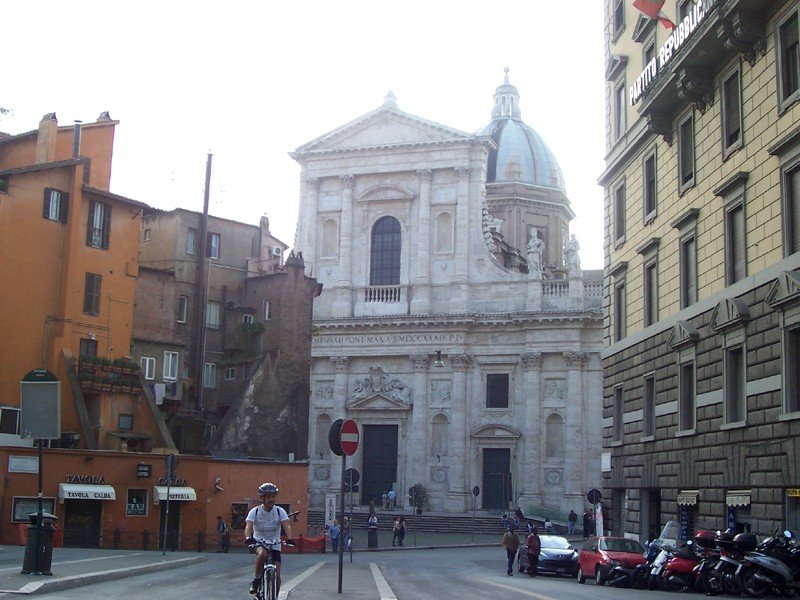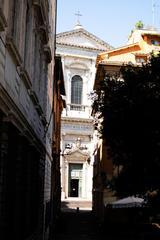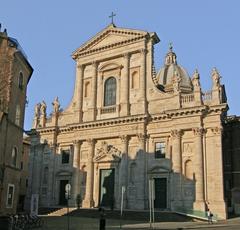
Basilica of San Giovanni dei Fiorentini, Rome: Visiting Hours, Tickets, and Historical Significance
Date: 14/06/2025
Introduction
Nestled at the northern end of Via Giulia, the Basilica of San Giovanni dei Fiorentini is one of Rome’s most distinguished religious and architectural landmarks. Serving as the national church for the Florentine community in Rome, it stands as a testament to centuries of artistic, cultural, and spiritual exchange between Florence and the Eternal City. From its medieval roots to its grand Renaissance and Baroque transformations, the basilica offers a journey through history, art, and faith, shaped by visionaries like Donato Bramante, Jacopo Sansovino, Carlo Maderno, and Francesco Borromini. The church’s iconic dome and richly decorated interior chapels make it a must-visit for art lovers, history enthusiasts, and travelers seeking to experience the depth of Italy’s religious heritage (Roman Churches Wiki; HelloMondo; Turismo Roma).
Historical Overview
Medieval Beginnings
Before the present basilica, the site was occupied by a small church known as Sancti Pantaleonis iuxta Flumen (“St Pantaleon next to the river”), first recorded in 1186. This church, likely dating to the 10th or 11th century, served the local population until the 15th century, when demographic shifts led to its decline (Roman Churches Wiki).
The Florentine Community’s Vision
The modern basilica owes its existence to the vibrant Florentine expatriate community in Rome. In 1448, following a devastating epidemic, the Florentines established the Compagnia della Pietà dei Fiorentini, a confraternity devoted to caring for the sick and ensuring dignified burials for their compatriots. By 1508, they had settled at the church of San Pantaleone.
Pope Julius II’s urban renewal projects, including the creation of Via Giulia, inspired the Florentine community to commission a grand church that would reflect both their faith and civic pride.
Architectural Competition and Construction
In 1518, an architectural competition was held, attracting luminaries like Raphael and Jacopo Sansovino. Sansovino’s plan was selected, and construction began in 1519, with the support of Pope Leo X, himself a Florentine. However, foundational challenges and financial setbacks delayed the project, and Sansovino ultimately withdrew (Roman Churches Wiki).
Over the next two centuries, architects such as Antonio da Sangallo the Younger, Giacomo della Porta, Carlo Maderno, and Francesco Borromini contributed to the evolving design. Maderno completed the nave and the basilica’s distinctive dome around 1620, while Borromini and later Alessandro Galilei shaped the sanctuary and façade.
Artistic Heritage and Notable Burials
San Giovanni dei Fiorentini is a showcase for Renaissance and Baroque art. Noteworthy highlights include:
- The Sacchetti Chapel by Carlo Maderno, featuring a bronze crucifix and works by Giovanni Lanfranco.
- The Falconieri Chapel by Borromini, with a Baptism of Jesus by Ercole Antonio Raggi.
- Paintings and funerary monuments by artists such as Salvator Rosa, Alessandro Algardi, and Ercole Ferrata.
- The tombs of Carlo Maderno and Francesco Borromini, two giants of Baroque architecture.
The basilica also houses a revered relic: a bone from the foot of Saint Mary Magdalene, enshrined in a silver reliquary, making it a significant pilgrimage site (The Catholic Travel Guide).
The Florentine Nation in Rome
Throughout its history, the basilica has served as the spiritual and social hub for Florentines in Rome. The adjacent Ospedale della Nazione Fiorentina, established in 1607, provided medical care and hospitality, reinforcing the church’s role as a center for community support (Roman Churches Wiki).
Architecture and Artistic Highlights
Architectural Evolution
The basilica represents a harmonious blend of Renaissance order and Baroque grandeur. Its façade, designed by Alessandro Galilei and completed in the 18th century, features six statues of saints and the emblematic fleur-de-lys of Florence. The dome, completed by Carlo Maderno, is a hallmark of Baroque engineering, nicknamed “il confetto succhiato” (the sugared almond) by Romans (Turismo Roma).
Interior and Chapels
Inside, the basilica boasts three naves separated by columns, richly decorated chapels, and an ornate high altar. The Falconieri Chapel, designed by Borromini, is particularly notable for its sculptural program, featuring works by Ercole Ferrata and Domenico Guidi. The church’s chapels and monuments serve as a testament to the artistic tastes and devotional practices of Rome’s Florentine community.
Museo San Giovanni de’ Fiorentini
Adjacent to the basilica, the Museo San Giovanni de’ Fiorentini displays a collection of religious art and artifacts, including a statue of a young St. John the Baptist, traditionally attributed to Donatello, and works by Gian Lorenzo Bernini (HelloMondo).
Religious and Cultural Significance
Dedication and Florentine Identity
Dedicated to St. John the Baptist, the patron saint of Florence, the basilica was commissioned by Pope Leo X to serve the city’s large Florentine population. Its proximity to the Palazzo dei Fiorentini—the former Florentine consulate—underscores its central role in the life of the expatriate community (Turismo Roma).
Relics and Pilgrimage
The church’s most famous relic, a bone from Mary Magdalene’s foot, draws pilgrims from around the world, particularly during jubilee years (Iubilaeum 2025). The basilica’s inclusion among Rome’s “Jubilee Churches” further highlights its importance as a site of spiritual renewal.
Saint Philip Neri
Saint Philip Neri, a Florentine and founder of the Congregation of the Oratory, served as the basilica’s first parish priest from 1564-1575. His legacy is commemorated by a dedicated chapel and annual celebrations (Turismo Roma).
Visiting San Giovanni dei Fiorentini
Location
- Address: Via Acciaioli 2, 00186 Rome, Italy
- Neighborhood: Rione Ponte, at the end of Via Giulia, near Ponte Sant’Angelo (Rome City Now)
How to Get There
- Metro: Lepanto (Line A), approximately 15 minutes on foot.
- Bus: Multiple lines stop nearby.
- Walking: Easily accessible from the Vatican and Rome’s historic center.
Opening Hours
- General Visiting Hours: Daily, typically from 9:00 AM to 12:30 PM and 3:30 PM to 6:00 PM. Some sources report 7:00 AM to 12:30 PM and 4:00 PM to 7:00 PM; hours may vary on weekends and during religious services.
- Mass Times: Sightseeing is not permitted during Mass. Check with the parish for the latest schedule (Sito Ufficiale; Churches of Rome.info PDF).
Tickets and Admission
- Entry: Free of charge; donations are welcome.
- Guided Tours: Available upon request and highly recommended for an in-depth experience. Tours can be arranged through the parish office or local operators.
- Museum Entry: Included with church visit; some exhibitions may require a ticket.
Accessibility
- Wheelchair Access: Ramps available at the main and side entrances.
- Facilities: No restrooms inside; public facilities are available nearby.
Dress Code and Etiquette
- Dress Modestly: Shoulders and knees should be covered; no shorts or low-cut tops (Rome Vacation Tips).
- Photography: Allowed without flash; always be respectful, especially during services.
Practical Travel Tips
- Best Time to Visit: Early mornings or late afternoons on weekdays for a quieter experience.
- Footwear: Comfortable shoes recommended for marble floors and cobbled streets.
- Safety: Watch out for pickpockets in busy areas.
Highlights and What to See
- Façade: 18th-century Baroque design by Alessandro Galilei, adorned with statues and the Florentine fleur-de-lys.
- Dome: A defining Baroque feature completed by Carlo Maderno.
- Main Altar & Chapels: Exceptional artworks by Raggi, Borromini, Ferrata, Guidi, and others.
- Relics: The revered foot bone of St. Mary Magdalene.
- Tombs: Burial sites of Borromini and Maderno.
- Museum: Sacred art and artifacts, including pieces attributed to Donatello and Bernini.
Nearby Attractions
- Via Giulia: A scenic Renaissance street.
- Ponte Sant’Angelo and Castel Sant’Angelo: Iconic landmarks a short walk away.
- Piazza Navona and Vatican City: Easily accessible for an extended tour (Rome City Now).
Frequently Asked Questions (FAQ)
Q: What are the basilica’s visiting hours?
A: Typically 9:00 AM–12:30 PM and 3:30 PM–6:00 PM, but check the official website for updates.
Q: Is there an entrance fee?
A: No, entry is free; donations are appreciated.
Q: Are guided tours available?
A: Yes, by advance arrangement with the parish office or local operators.
Q: Is the basilica wheelchair accessible?
A: Yes, ramps are available; some chapels may have limited access.
Q: Can I take photos inside?
A: Yes, non-flash photography is permitted except during religious services.
Q: How can I reach the basilica?
A: By metro (Lepanto station), bus, or on foot from the historic center or Vatican.
Contact Information
- Address: Via Acciaioli 2, 00186 Rome, Italy
- Phone: +39 06 6869892 / +39 06 68892059
- Website: Parrocchia San Giovanni Battista dei Fiorentini
Explore More
Conclusion
The Basilica of San Giovanni dei Fiorentini is a remarkable blend of Florence’s spiritual tradition and Rome’s architectural innovation. Its rich history, stunning Baroque dome, sacred relics, and vibrant role in the life of Rome’s Florentine community make it a rewarding stop for any visitor. Plan your visit by checking the latest hours, consider a guided tour for deeper context, and enjoy discovering the treasures of this historic basilica and its surroundings.
Sources
- San Giovanni dei Fiorentini – Roman Churches Wiki
- Basilica di San Giovanni Battista dei Fiorentini – HelloMondo
- Basilica San Giovanni Battista dei Fiorentini – Turismo Roma
- Rome City Now: San Giovanni dei Fiorentini
- Churches of Rome.info PDF Guide
- The Catholic Travel Guide
- Iubilaeum 2025: Chiesa San Giovanni Battista dei Fiorentini
- Rome Vacation Tips: Dress Code



















































































































































































































































